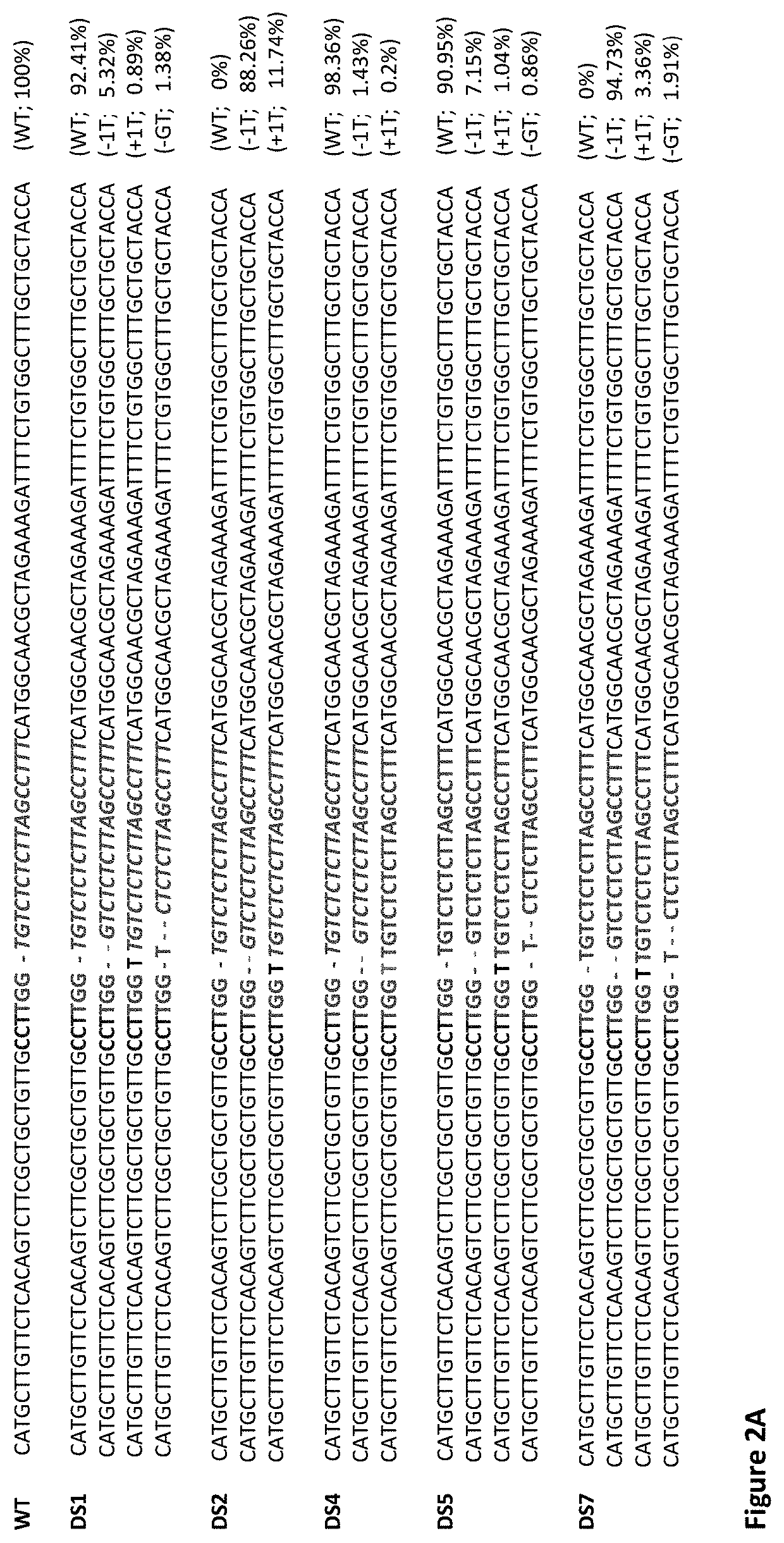Targeted editing of citrus genes for disease resistance
a technology of disease resistance and citrus, applied in the field of disease resistance-targeted editing of citrus genes, can solve the problems of unmarketable infected citrus fruit etc., and achieve the effects of reducing orange acreage and yield in florida, severe crop yield loss, and reducing commercial valu
- Summary
- Abstract
- Description
- Claims
- Application Information
AI Technical Summary
Benefits of technology
Problems solved by technology
Method used
Image
Examples
example 1
Designing of Guide RNAs (gRNAs) to Target Specific Genes in Citrus
[0062]1. Identifying candidate genes for gene editing[0063]A thorough literature review identified two genes, SWEET1 and DMR6, as candidate genes for gene editing.[0064]SWEET=Sugars will eventually be exported transporters.[0065]DMR=downy mildew resistance.
[0066]SWEET genes encode one of the several types of sugar transporters, and their proteins are located in the plasma membrane of cells, thus facilitating the efflux of sugars for a variety of purposes. These sugar transporters are often hijacked by plant pathogens for supply of sugars as a source of nutrients for the pathogens to infect plant cells and multiply within infected cells (Gupta, 2020). SWEET genes are now known in more than 30 plant species. In at least 10 of these species, some of the SWEET genes function as disease susceptibility genes (S genes) (Streubel et al., 2013). In rice, five naturally mutated SWEET genes confer resistance to Xanthomonas oryza...
example 2
Developing Gene Constructs for Effective CRISPR / Cas9-Based Gene Editing
[0077]The plasmid vector pS1g1g2-Cas9 was assembled for editing the SWEET1 gene in Citrus, including ‘Duncan’ grapefruit. FIG. 1A shows a schematic diagram of this vector within the left and right transfer DNA (T-DNA) borders. In this gene editing vector, the GFP-NPTII fusion protein gene was driven under the 2X Casava mosaic virus (Casmv) 35S promoter, the SpCas9 gene was driven by the Cauliflower mosaic virus (Camv) 35S promoter, and the gRNA (SWT1_gRNA1) targeting the SWEET1 gene was driven under the Arabidopsis U6 promoter. To assemble the pS1g1g2-Cas9 vector, primers were designed for the gRNA (SWT1_gRNA1) with BsaI restriction sites to amplify ptRNA-scaff plasmid. The PCR product were gel-purified and ligated using the Golden Gate (GG) Assembly protocol with the BsaI enzyme. The GG product was amplified using S5Fok5-F and S5Fok3-R primers to add FokI restriction sites. The amplified PCR product was gel-puri...
example 3
Delivering the Gene Constructs into Citrus Cells and Regenerating Citrus Shoots Containing Cas9 and gRNAs
[0079]The gene editing constructs or plasmids were delivered into Citrus cells through Agrobacterium tumefaciens-mediated stable transformation and regeneration of Citrus shoots carrying and expressing SpCas9 or Hypa-Cas9 gene and gRNAs was through organogenesis (FIG. 1C-1F). Details are as follows:
[0080]The above developed CRISPR / Cas9 plasmids, pS1 g1g2-Cas9 and pD6g1 g2-HyCas9, were electroporated separately into Agrobacterium tumefaciens strain EHA101 cells. Transformed Agrobacterium EHA101 was selected and used for delivering the gene editing plasmids into Citrus cells. In each experiment, the Agrobacterium cells were grown overnight at 28° C. Then the cells were harvested and adjusted to an optical density 0.5 (OD600 0.5) prior to use to deliver the gene editing components.
[0081]Seeds (peeled, containing apomictic nucellar embryos) of ‘Duncan’ grapefruit (DGF) and ‘Carrizo’ ...
PUM
| Property | Measurement | Unit |
|---|---|---|
| optical density | aaaaa | aaaaa |
| length | aaaaa | aaaaa |
| size | aaaaa | aaaaa |
Abstract
Description
Claims
Application Information
 Login to View More
Login to View More - R&D
- Intellectual Property
- Life Sciences
- Materials
- Tech Scout
- Unparalleled Data Quality
- Higher Quality Content
- 60% Fewer Hallucinations
Browse by: Latest US Patents, China's latest patents, Technical Efficacy Thesaurus, Application Domain, Technology Topic, Popular Technical Reports.
© 2025 PatSnap. All rights reserved.Legal|Privacy policy|Modern Slavery Act Transparency Statement|Sitemap|About US| Contact US: help@patsnap.com



